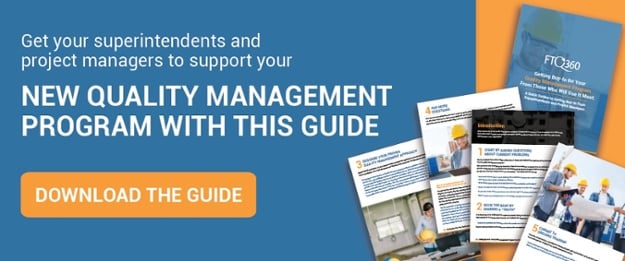
Building consensus around a construction quality program is necessary if you want your project management to go smoothly. If you don’t involve key stakeholders, you are likely to face resistance.
On the other hand, if you take the time to learn more about the thoughts of others on the team, you are more likely to get early buy-in and adoption of any new management systems you roll out.
As the ultimate authority on the job site, superintendents are essential participants in any construction quality program. If they feel that their authority is being ignored by a quality manager, the relationship between you can become tense.
If first-time quality is the goal, the entire team must be on board—especially superintendents. So talk to your superintendent and learn their thoughts on quality management and what's important to them. Maintaining a healthy and productive relationship is an important part of building consensus around your quality program, which includes quality control and quality assurance measures.
Superintendent Concerns About Quality Management
One of the primary concerns superintendents have about construction quality management is that it will take more of their time and resources without helping them. They are also distrustful of nit-picky quality inspectors finding minor defects and keeping the project from moving forward—it’s even worse when an unqualified junior person is performing inspections.
Superintendents tend to see quality management as an obstacle that gets in the way, rather than a strategy that can keep the project running smoothly. When superintendents see so much downside and not much upside, it puts quality managers in a challenging position from the beginning. When building consensus, it’s the quality manager’s job to address these concerns—ideally before they arise.
How Quality Management Can Support Superintendent Goals
Align Goals
The first step in building consensus is matching quality to the superintendent's goals. When the quality manager and superintendent work together to define quality, including the construction quality control plan, the superintendent can lead the conversation based on his experience with client expectations. For example, experienced superintendents know the level of finished work that is generally acceptable, and it's important that the quality manager not impose a higher level of quality based his own notion of what is acceptable.
Learn the superintendent’s concerns about what might go wrong. Things like new technologies that could cause a problem, subcontractors who have been problematic, or a new contractor with unknown reliability. Understanding these concerns gives quality managers direction for preventing issues in ways that support the superintendent's goals. A quality manager can then go about preventing project risks using better project documentation, pre-construction meetings, and high risk checkpoints on checklists.
Support Subcontractor Performance
Subcontractors are critical to the success of any construction project. When they don't perform to the expected standards, it negatively impacts quality. Superintendents want to avoid working with subcontractors that don't take the job requirements into account and leave it to others to find what's wrong and fix it. Therefore, having clear quality control procedures and a capable quality control manager can ensure that subcontractors meet the expected standards and contribute positively to the overall quality of the project.
A construction quality program can influence the way subcontractors approach your projects and ultimately lead to first-time quality. Quality managers can educate subcontractors on the business implications of first-time quality and make it clear that their performance will be evaluated and tracked internally.
Quality managers also help subcontractors succeed at first-time quality. This involves communicating expectations, providing field training, and preventing issues from recurring.
Save Time and Resources
Avoiding defects in the first place will ultimately save time on redoing work and keep project budgets in check. While it's true that some planning will be required up front when rolling out a new quality management program, a smart superintendent will recognize the long-term value and become invested in the construction process—but only if they are involved from the beginning. Hence why, it's important to involve the superintendent in the development of the construction quality management plan and the implementation of quality management systems to ensure their buy-in and long-term commitment to the project's success.
Better Client Satisfaction
Superintendents want clients to be satisfied, and they understand the importance of meeting project quality specifications to achieve this goal. They are just as invested in controlling quality as the quality manager is. When both parties work together with that end in mind, the process can be collaborative and supportive, rather than tense. By working together to control quality, the superintendent and quality manager can ensure that the project meets the required quality standards and that the client's expectations are exceeded.
Quality managers who treat superintendents as their customers also tend to be more successful at building consensus. Establishing the relationship as one in which the quality manager’s role is to support the superintendent’s goals will set the stage for a smoother process.
Quality managers can take on responsibilities to ease the superintendent’s burden, including verifying that work is done to specifications, acting as a middleman with others, and handling reports, submittals, and inspections.
Building Consensus Leads to Lasting Change
When you start by getting buy-in from all of the key team members, introducing a new construction quality program will be much easier. Every stakeholder matters when it comes to quality management, but without consensus from superintendents, any program that is implemented might not be used to its fullest potential.
Quality managers and superintendents can and should work together to implement a program that leads to first-time quality. The superintendent’s role is to lead, so let them do that, and make it clear that you understand the relationship and can provide the systems and processes to support them in the effort to achieve first-time quality.

